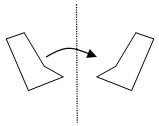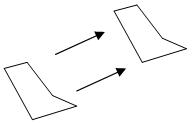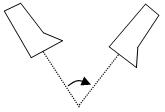The key idea of transformation at level 1 is that the position and appearance of an object can be changed by reflecting (flipping), translating (sliding) and rotating (turning) it.
At level 1 students understand that objects can be moved in space. Changes to the position of an object can be described in terms of transformations, which include:
- Reflections (flip). Objects can be reflected or flipped through lines which are external to the shape, or which run through the shape. Objects which have been reflected are described as mirror images of the original object.
- Translations (slide). Objects that have been moved by translation, or sliding, look the same as the original object, but they are in a different position.
- Rotations (turn): Objects are turned in a circular motion around a fixed point, which is called the centre of rotation. The centre of rotation can be inside or outside the shape itself. The amount the object is turned is called the angle of rotation.
At this level students need to recognise these transformations and understand their effects on simple shapes.
This key idea develops from informal exploration with moving objects during the pre-school years.
This key idea is extended to the key idea of transformation at level 2 where symmetry is introduced and students learn some objects do not change position or appearance under some reflections and rotations.


